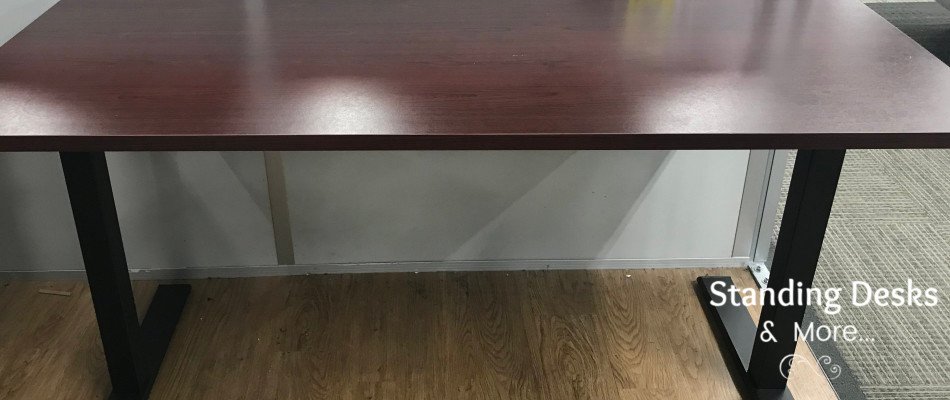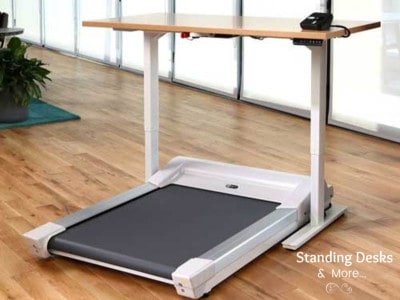
Prolonged sitting is bad for your health. It can increase your risk of certain diseases such as cancer, diabetes, and cardiovascular diseases.
Prolonged sitting also causes varicose veins, hip and back pain, and stiffness on the shoulders and neck.
In addition, sitting all day with limited movement is linked to weight gain and obesity.
It’s a good thing standing desks were invented. A standing desk offers a number of ergonomic benefits. For instance, a standing desk allows you to stand while working which helps you achieve proper posture and stay away from a sedentary lifestyle.
In this article, I will share with you the ergonomic benefits of standing desks. Read on and find out what they are.
9 Ergonomic Benefits Of Standing Desk
1.Helps maintain proper posture
When you are sitting while working, your tendency is to be too comfortable on the chair. As a result, you slouch and stay in one position for a long time until your body hurts.
On the other hand, standing makes you more conscious of what your body feels. When your feet start to ache, your tendency is to move your feet and change position.
You also tend to stretch your body more when you are standing. In other words, standing encourages your body to move more compared to when you are sitting.
Watch this video about the effects of sitting for too long:
2. Standing can help reduce your risk of gaining weight
Although standing may not be able to help you lose weight, it is a good way to reduce your risk of gaining weight.
According to the article published on the Harvard Health Publishing, standing for three hours burns an extra 24 calories compared to sitting.
In addition, standing allows you to move freely. The more you move, the more calories you burn. It may not be significant for weight loss but it’s a good way to prevent yourself from gaining weight.
That being said, when you stand, you tend to do more than just stand. When you are standing, you tend to move your body more, you stretch your arms and legs, shift from one position to another, move your feet, and even dance.

If you want to burn more calories while standing at work, you can use a standing desk treadmill. Check the article I wrote about standing desk treadmills to help you decide if it’s really for you.
3. Standing Desk Can Help Reduce Back Pain
Standing helps you with proper posture. It also encourages you to move more and stretch more.
The act of stretching and moving from one position to another helps reduce back pain.
Also, when you stand, your core and back muscles are engaged. This means you hold your upper with your muscles. This leads to better posture.
When you sit, you let the chair hold your body. So your tendency is to slouch and let the chair carry your body.
This is why you get back pain when you sit for too long. When you sit, you also tend to put your weight on one side of your body, causing stress.

This can lead to repetitive stress injuries. According to WebMD, “all of these disorders are made worse by the repetitive actions of daily living.”
It is best to alternate from sitting to standing all throughout your workday. It is also advisable to do some light stretching and walking a few steps once in a while.
4. Standing Desk Can Help Reduce Your Risk Of Cardiovascular Diseases
It has been proven by studies that sitting for a long time can increase the risk of cardiovascular diseases.
According to a study published in 2012, prolonged sitting increases the risk of cardiovascular diseases by 147%.
Another study also showed that standing helps reduce the risk of heart-related conditions by 50%.
In this particular study, researchers found out that bus conductors whose job requires them to stand most of the time have a lower risk of cardiovascular diseases.
Prolonged sitting causes a lot of health issues that even when you exercise for a full hour, its negative effects still linger.
5. Using A Standing Desk At Work Helps Lower Your Risk Of Diabetes
After taking your meal, it is advisable to stand for a while rather than sit all the way.
According to a small study conducted in 2014, standing after a meal helps reduce blood glucose levels spike by 43%.
As per the study, the low blood glucose spike is due to standing and not from additional physical movements around the office.
It goes to show that standing does help reduce the risk of diabetes. Those with Type II Diabetes will benefit from this as well.
It will be a good practice to stand after every meal to help lower your blood sugar spike.
6. Using A Standing Desk Helps Reduce Your Risk Of Early Mortality
Prolonged sitting is associated with an increased risk of cardiovascular diseases, diabetes, and other diseases associated with a sedentary lifestyle.
Using a standing desk allows you to stand more and move more while working. Logically speaking, the less you sit, the healthier you are which means you have a better chance of living longer.
Also, since you get to move more and stretch your muscles more, your risk of acquiring diseases associated with a sedentary lifestyle is lesser. Which also increases your chance of living a longer life.
7. Using A Standing Desk At Work Helps Boost Your Productivity
At first, I was also hesitant about using a standing desk. In my mind, I thought about how I will type using a standing desk.
I was thinking that it might affect the way I am typing and that I might not be able to complete my tasks.
However, to my surprise, I was proven wrong. My typing was not affected at all. I am able to complete my task and I can tell, my typing is way more relaxed than when I am sitting.
I usually feel a tingling sensation on my arms when I am working and sitting on my desk and my shoulder feels heavy. But, when I am working in front of my standing desk, I barely feel the stiffness on my shoulders and the tingling sensation on my arms.
8. Standing Helps Alleviate Your Mood
Using a standing desk at work has shown great results for the overall health of employees.
This is why standing desks are gaining popularity. Even employers are taking notice.
In this study conducted in Minnesota, employees with sedentary jobs were either given a standing desk to use at work or not.
Among those employees, 24 were given standing desks to use during work hours and 10 were not. As a result, those who were given a standing desk for work have experienced reduced neck and back pain by 54% and their moods improved.
In addition, the employees who were given standing desks to use for work reported better energy and vigor all throughout the day.
They also reported lesser fatigue and stress compared to their counterparts who were sitting while working.
Naturally, when you have better energy levels and a better mood, you work better and you get along with your coworkers better. The result, better productivity.
9. Use Of Standing Desks At Work Gives You Better Movability
Adjustable stand-up desks are not only for standing. You can interchange them for sitting and standing.
This means you are able to change from a standing position to a sitting position when needed.
Also, standing desks give you more space to move from so you can easily stretch in front of your desk from time to time.
Even in a limited space, with a standing desk, you are at least able to stretch or move forward and backward when you need to move your body.
Standing desks comes in different sizes, designs, and styles. To find out which standing desk is best for you, check the article I wrote about stand up desks.
Standing Desk Best Practices
Transitioning from sitting to standing at work is not that easy. You’re used to sitting all day working then suddenly, you are standing.
To help you transition smoothly from sitting to standing and maximize the benefits of a standing desk, follow these standing desk best practices:

▪️Check Your Posture
When standing in front of your standing desk, keep your neck, torso, and legs in line. Your elbow should rest comfortably on the surface of your desk.
Your wrist and neck should remain neutral at all times.
To maintain proper posture at all times, do the following:
▪️ Adjust the placement of your monitor. Place the tip of your middle finger on your screen. Keep it straight. The distance between the tip of your middle finger and your elbow is the distance between your eyes and your monitor.
If your monitor is too near or too far, it can cause strain to your eyes which can eventually lead to pain and other eye conditions.
Also, to avoid eye strain, slightly tilt your monitor so the tip is at your eye level.
▪️ Keep your elbows near your body. When standing in front of your standing desk, rest your elbows on the surface of your desk. Your wrist must remain neutral.
Doing so will ensure that your shoulders will not stiff and it will minimize the occurrence of lower back pain.
Your keyboard and mouse should be on the same surface.
▪️ Use a footrest. A standing footrest or standing mat allows you to shift your weight from foot to foot while minimizing strain on your legs.
▪️ Wear comfortable footwear. There is no right and wrong when choosing the right shoes for you. What is important is your comfort.
Choose a shoe that is comfortable and does not constrict your toes. A shoe that is too tight can restrict blood flow on your legs and can lead to pain and discomfort.
As much as possible, veer away from high heels when standing. It can cause strain on your legs and soreness on your feet.
▪️ Choose Your Standing Desk Accordingly
While looking for the right standing desk for you, consider the height and depth of the standing desk.

The height of your desk must correspond to how tall you are. To check the best standing desk height for you, stand in front of the desk.
Place your arms on your side, shoulders back. Place your elbow on the surface of the desk and make a 90-degree angle.
Your body should be straight, your neck neutral and your wrist neutral. If you are not able to do so, you need to adjust the height of your standing desk.
If it’s a fixed-height standing desk, you can either use a converter desk or look for another standing desk that is right for you.
Another important feature to remember is the depth of the standing desk.
Although standing desks are designed to be able to accommodate your monitor, keyboard, and mouse, you also have to consider the depth of the desk.
Remember, your monitor should be at least 20 inches away from your face. You should be able to place your arms straight on your monitor.
If it’s too deep, you can use a desk converter or look for another standing desk with reasonable depth.
▪️ Keep your frequently used items near you. Place all the key objects you frequently use near you to prevent too much stretching.

When you are too focused on your task, your tendency is to reach for objects carelessly. Too much stretching or mindlessly reaching for something away from you can cause muscle strain.
To prevent this from happening, place all the things that you frequently use such as stapler, telephone, or printed materials near you so you can easily grab them when needed.
Tip: If you are frequently using a telephone, use a headset instead or put it on the speaker mode instead of placing the phone in between your neck and head to prevent straining.
▪️ Sit, Stand, Move
Make it a habit to alternate from standing to sitting and stretching or walking.
The idea here is to minimize sitting, not to completely eliminate it. When you start to feel a strain on your legs or back, move your body.
Walk a few steps back and forth from your desk and do some simple stretching. After a while, sit for a few minutes to relax your muscles. After about 15 to 20 minutes, you can stand again.
If you are using a height-adjustable standing desk, it is also a good idea to get an ergonomic chair so you can easily transition from standing to sitting and vice versa.
Related Questions
Are standing desks better for posture?
In my opinion, if used properly, yes. Standing desks are better for posture compared to sitting all day in front of your desk.
Adjustable stand up desks allows you to sit and stand anytime. This means you have better mobility and you have a better opportunity to move anytime.
When you are standing. you are more aware of what is happening to your body so you act on it faster compared to when you are sitting.
If you feel your shoulders are stiff or your legs are starting to cramp, your tendency is to move, shift your position, and straighten your body.
Sitting for too long is associated with a lot of health risks such as high blood pressure, type 2 diabetes, high cholesterol, weight gain, cardiovascular diseases and pain in the back and neck.
Using a standing desk at work helps minimize the risks of these diseases.
Where should your standing desk be?
Standing desks are easy to place anywhere in your room. They don’t take up much space. That is one of the reasons I like standing desks.
There are also standing desks with wheels which you can easily move from one corner to another. If you love decorating your workspace a lot and you like moving things, this type of standing desk is for you.
If you are working from home, it would be best to place your standing desk where there is enough light to minimize the strain on your eyes.
If your work requires you to be on the phone most of the time, choose a corner that is quiet. Place your standing desk away from the spot where people in your house usually stay.
Make sure that you have enough space to move from. If you have limited space, choose a standing desk with round edges as your risk of bumping into things is higher.
How long are you supposed to stand at a standing desk?
Ideally, the maximum time that you can stand in front of your desk without changing position is 2 hours. Anything more than that can already lead to muscle strain, lower back pain, and other health issues such as cardiovascular diseases and varicose veins.
For some, to prevent themselves from standing for too long, they use a standing desk alarm to remind them that it is time to move, stretch, walk and sit.
In my case, I do not use an alarm. Once I feel tired, or I feel a sensation on my back, legs or arms, I stop, move my body, stretch a bit and go back to work.
However, when I start to feel a sensation on my legs like there are hundreds of ants marching in my legs, I stretch my legs slowly and sit for 15 to 20 minutes. I usually rest my feet on top of a high table or a chair until the muscles relax.
You know your body more than anybody else. Listen to it and move whenever necessary.
